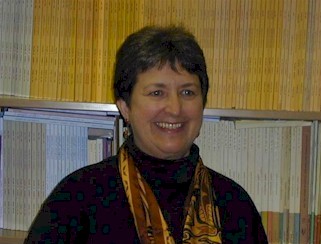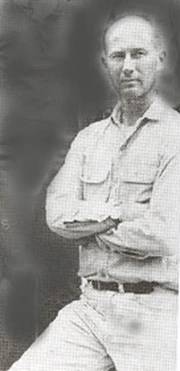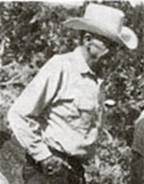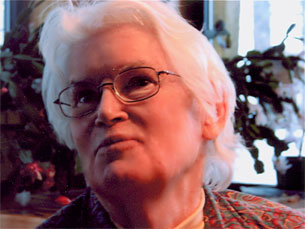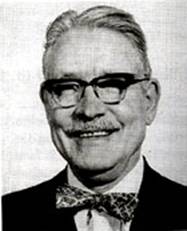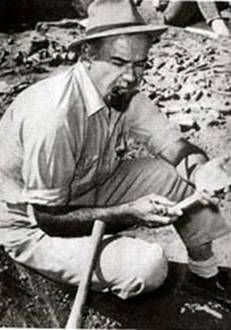Fellows
A CCPA Fellow is an individual recognized as a senior scholar in archaeology or related discipline, as well as someone that has made a substantial contribution to Colorado archaeology through both research and service.
Adrienne Anderson (b. 1944)
Adrienne Anderson spent her early years romping around Scottsdale, AZ. She migrated to Tucson, AZ to attend the University of Arizona where she received her B.A. in 1966 and her M.A. in 1970. Next her wanderlust brought her to Boulder, CO where she received her PhD. from the University of Colorado, Boulder in 1975.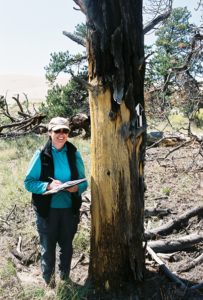
Dr. Anderson retired in 2009 after more than 37 years serving in various archaeological positions with the National Park Service, including Regional Archeologist for the Rocky Mountain Region and Program Manager of the Cultural Resource Program for the Colorado Plateau Cluster of Intermountain Region Parks. While she has carried out and overseen a wide variety of archeological studies and programs throughout the Intermountain Region, of particular relevance to this project is her experience with the archeology and the archeological and preservation programs in all three districts of Canyonlands and nearby parks and her experience managing the preparation of district nominations for the National Register of Historic Places.
The first National Register Nomination that Dr. Anderson prepared was in 1972 for The Folsom Site, the type location in northeast New Mexico. While she has prepared and/or managed the preparation of a number of nominations, of particular relevance are the Curecanti Archeological District in Curecanti Recreation Area, the Parunuweap Canyon Archeological District in Zion National Park, and the Fog Creek Archeological District in Badlands National Park, all of which bring together a large number of individually significant as well as contributing archeological sites. The Parunuweap Canyon Archeological District, especially, is in a deeply incised, sheer rock walled canyon very much like Horseshoe Canyon. She also prepared the first archeological base map for Canyonlands National Park, including Horseshoe Canyon. Further, Dr. Anderson served 1981 – 1983 on the Colorado State Historic Preservation Review Board, which reviews and evaluates all National Register Nominations for the State of Colorado, including those on Federal lands.
As if she wasn’t busy enough building a stellar career with the Park Service, Adrienne found time to get involved locally with the Colorado Council of Professional Archaeologists where she is a charter voting member served as; President 1981, Board member 1988-1991, Newsletter Editor 1982-1984, Chair of the Ward F. Weakly Memorial Scholarship Fund 1989 – 2017. She also dipped her toes in the Plains Anthropological Society pool where she served as; Board of Directors 1975-1978, Secretary to the Board, 1977- 1978.
Throughout her career Adrienne found heaps of recognition thrown at her. A select few of these are; 1997 Department of the Interior Superior Service Award, 2002 Utah Heritage Foundation Heritage Award, 2007 Intermountain Region Appleman-Judd-Lewis Award.
Adrienne was inducted as a CCPA Fellow in 2003.
James Bell Benedict (1938-2011)
Jim Benedict was born in Cincinnati, Ohio 11 November 1938. As a child, he explored the rich Ordovician shales and limestones for fossils near his home, an activity that began his lifelong love of geology and natural history. He graduated from Phillips Andover Academy and then served a stint in the Marines. Following that, he entered the University of Colorado, graduating with a BS in Geology in 1961. He then entered the graduate program in geology at the University of Wisconsin-Madison, earning a PhD in Geology in 1968.
In 1963, while conducting high altitude studies at CU’s Institute of Arctic and Alpine Research (INSTARR) west of Boulder, he discovered the Murray game drive. He recognized a concentration of hunting blinds and drive walls, all encrusted in lichen colonies, and realized the potential of incorporating archaeological sites into his studies of high altitude climate and geology. He went on to establish the best lichen chronology in the New World, useful in aging cultural and geological features in the Front Range. In 1971, the year he married his beloved wife, Audrey, he established the Center for Mountain Archeology. He later described this move to archaeology by joking to geologists that he was “a backslider from geology into the social sciences” (GSA Kirk Bryan Award acceptance speech, 1975).His numerous publications include the highly-acclaimed Center for Mountain Archeology Research Report series (nine total) that concentrated on the archaeology and geology of the Indian Peaks region of the Front Range. He was well-known for his work on the Altithermal refugium model for the Rockies, and for his models of annual migration rounds in the Front Range. Jim’s talent for science was obvious in the meticulous and creative approaches he employed in all his projects, effectively weaving together data from highly disparate sources to form his conclusions. He was truly a multi-disciplinarian in the finest sense of the term.
Personal honors include being a member of Phi Beta Kappa, Sigma XI, a Fellow of the Geological Society of America, and was the winner of the Kirk Bryan Award (GSA) and the C. T. Hurst Award (Colorado Archaeological Society), and was a Research Associate for the Denver Museum of Nature and Science and a Faculty Affiliate at Colorado State University. Near the end of Jim’s life, they established the Jim and Audrey Benedict Mountain Archaeology Fund at CSU. Jim died 8 March 2011 after a hard-fought battle with kidney cancer.
Jim was inducted as a CCPA Fellow in 2011.
Kevin Dale Black (b. 1955)
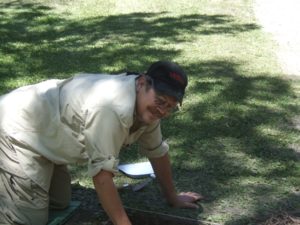
Kevin Black, Ute Memorial Site, 2015
Kevin Black was born in Tiffin, Ohio and first came west in 1972 on a college scouting trip. The University of Colorado in Boulder looked pretty good back then, and still mostly does, leading Kevin to stick around for degrees in 1977 (B.A.) and 1979 (M.A.–Anthropology). His first field school experiences were in Mesa Verde National Park, today’s Ute Mountain Tribal Park—it wasn’t yet a park in those days—the Uncompahgre Plateau, Middle Park, and in El Salvador, Central America. Working on Payson Sheet’s Protoclassic Project, Kevin was in charge of a large sampling survey in El Salvador’s Zapotitán Valley, which became the subject of his Master’s thesis. His early years of employment were spent as a staff archaeologist with consulting firms in Montrose (Centuries Research, 1979–81) and Eagle, Colorado (Metcalf-Zier, later Metcalf Archaeological Consultants, 1981–88), conducting inventories and excavations throughout the Rocky Mountain region—especially in Colorado, Wyoming and Utah. During those years, his involvement on numerous projects in higher elevation areas led to a continuing interest in the hunter-gatherer archaeology of indigenous mountain-dwelling populations. Late in 1988, Kevin took a position as the Assistant State Archaeologist at the Colorado Historical Society in Denver, today’s History Colorado. Expecting a five-to-seven year stint, almost 28 years later he looked up and noticed he was still there after teaching over 500 classes in the Program for Avocational Archaeological Certification (PAAC), managing the state permit system for archaeologists and paleontologists, and identifying a few million rocks in a few thousand shoe boxes. Kevin retired from History Colorado in mid-2016 with plans to do something else for a while. At the moment that includes his continued work with the Colorado Encyclopedia Project and the Rocky Mountain Anthropological Association. He is generally easy to track down at those early bird parties kicking off the CCPA annual meetings.
Kevin was inducted as a CCPA Fellow in 2014.
David Alan Breternitz (1929-2012)
My archaeological career probably began when I became a Charter Member of the Denver Chapter of the Colorado Archaeological Society, as a junior in high school.
My future was set in stone when I attended the University of Arizona Archaeological Field School at age 19 (After me, they never accepted another student who had just completed his freshman year of college!). I was on the faculty of the University of Colorado, Boulder, for 24 years and during that time I had the opportunity to direct a variety of archaeological projects: in 9 states; in Tunisia and Nigeria; Field School for 19 years; and, as Senior Principal Investigator for the Dolores Archaeological Project, for 7 1/2 years. Since “retirement” I have participated in 70 separate archaeological projects (1/2 day to 19 weeks in duration), mostly as a Crew Member and the majority in Southwest Colorado.
David was inducted as a CCPA Fellow in 1992.
Richard F. Carrillo (1945-2014)
Richard F. Carrillo was a La Junta, Colorado native who began his career in historical archaeology at Bent’s Old Fort National Historic Site during the mid-1960s. He received an associates of arts degree in 1968 from Otero Jr. College, and a Bachelor of Arts degree in Anthropology from the University of Kansas in 1971.
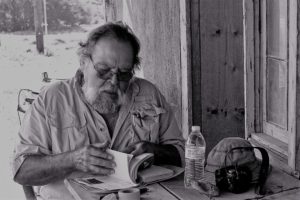
Richard at the Montoya Ranch
That same year he became associated with the Institute of Archaeology and Anthropology, University of South Carolina, Columbia and spent seven years undertaking historical archaeological research under the tutelage of Mr. Stanley South, one of the foremost historical archaeologists in the United States. Between 1978 and 1981, he entered private consulting and undertook historical archaeological studies in South Carolina. In 1981, Richard returned to Colorado and worked as an historical consultant on two projects at John Martin Reservoir. From 1987 through 2013, he was a private consulting historical archaeologist conducting historical archaeology and architectural surveys and archaeological excavations funded by local, state, and federal government agencies and for large cultural resource management firms and universities. In 2000 he formed Cuartelejo Historic Preservation (HP) Associates Inc., a consulting firm that specialized in the development of historical and archaeological contexts for cultural remains relating to borderlands, historical, urban and industrial archaeology, archival and historical research, general historic preservation and cultural resource management studies. From 2000 to 2013 he served as a part-time instructor at Otero Jr. College and taught evening introductory courses in anthropology and archaeology. For many years, he served as historical archaeologist and the Director of Educational & Special Projects for Boggsville Historic Site, an early 1860s village contemporaneous with Fort Lyon, located south of present-day Las Animas, Colorado.
Beginning in 2003, Richard was one of a handful of Colorado historical archaeologists and others who completed a new historical archaeology context for the State of Colorado. The project was completed in 2007 with the publication of Colorado History: A Context for Historical Archaeology. In 2008, Richard, in association with Colorado Preservation, Inc., conducted preliminary architectural and archaeological surveys on 450 sites on ranches located adjacent to the Piñon Canyon Maneuver Site (PCMS) in eastern Las Animas, southern Otero, and eastern Huerfano Counties. During 2009, 15 selected historic and six prehistoric sites located in 2008 were subjected to intensive recording. When he became a Felllow in 2013, he was in the process of completing a similar project in Bent County and had just completed a detailed Class III historical and archaeological assessment of Bent’s New Fort, constructed by William Bent after abandoning his original adobe fort, in the early 1850s. Without a doubt, Richard was the preeminent archaeologist and historian in Southeastern Colorado, and was generous with his time and knowledge, encouraging and mentoring the next generation of historical archaeologists working in Southeast Colorado.
Richard was a member of the Society for American Archaeology, the Society for Historical Archaeology, Colorado Archaeological Society, Colorado Council of Professional Archaeologists (past board member & and co-planner of the 2011 annual conference in La Junta), Colorado Preservation, Inc. (board member 1998-2001); Bent’s Fort Chapter, Santa Fe Trail Association (Past-President (2002-2003); Pioneer Historical Society of Bent County (past board member), and in 2001 served on the Penrose House Advisory Board for El Pomar Foundation. In 2006 he completed the second four year term as a non-attorney member of the Judicial Performance Commission for the Sixteenth Judicial District. In 2001 he was appointed by Gov. Bill Owens to the Colo. Historic Preservation Review Board (CHPRB). The appointment was renewed in 2004 for a third and final term (completed at the end of 2006). In late 2010, he was reappointed to the CHPRB by Governor Bill Ritter for a three-year term. Richard passed away suddenly on September 21st, 2014.
Richard was inducted as a CCPA Fellow in 2013.
Edward Stephen Cassells (b. 1945)
E. Steve Cassells was born at a Navy base in California on 6 August 1945, the day the first atomic bomb was dropped on Hiroshima, making him an official baby “boomer”. Steve took his first geology course in 1967 at Chadron State College (NE) from Larry Agenbroad, and that inspired him to choose archaeology as his profession.
He entered the University of Arizona, and was on the crew at the Murray Springs Clovis site, directed by Vance Haynes and Larry Agenbroad during those years. He earned an M.A. in 1972, and served in the U.S. Army before becoming an anthropology professor at Judson College (IL). He was the Forest Archeologist for the Gunnison National Forest and then became the Colorado Assistant State Archaeologist in 1978. He then started Plano Archaeological Consultants. During those years he wrote The Archaeology of Colorado and Prehistoric Hunters of the Black Hills, was awarded the C. T. Hurst Award by the Colorado Archeological Society, and served as President of CCPA. He then entered the University of Wisconsin-Madison, where he earned a Ph.D. in 1995 under the mentoring of Jim Stoltman and Vance Holliday. His excavations at the high-altitude Sawtooth game drive, with the help of Jim Benedict, formed the basis for his dissertation. Steve and wife Jill now live in Longmont, and he is an anthropology professor at Laramie County Community College in Cheyenne.
Steve was inducted as a CCPA Fellow in 2010.
Susan Marlias Chandler (b. 1953)
Susan Chandler, a western Colorado native, has been involved in Colorado and Southwestern archaeology since the early 1970s. She earned her BA in Southwest Studies from Fort Lewis College in 1975. From 1974 to 1977, she developed her archaeological skills as a field and laboratory archaeologist at Black Mesa and the Grand Canyon in northern Arizona and in 1977 received her Master’s degree in Anthropology from the University of Colorado.  In 1978, she landed a job as a contract archaeologist in Montrose and the following year married fellow former CU student and coworker Alan Reed. From 1979 to 1988 she worked as a staff archaeologist and project director at Nickens and Associates in Montrose. In 1988, she founded Alpine Archaeological Consultants with Alan Reed and Jon Horn.
In 1978, she landed a job as a contract archaeologist in Montrose and the following year married fellow former CU student and coworker Alan Reed. From 1979 to 1988 she worked as a staff archaeologist and project director at Nickens and Associates in Montrose. In 1988, she founded Alpine Archaeological Consultants with Alan Reed and Jon Horn.
Susan has ably served the best interests of Colorado archaeology since the 1980s. She has been a CCPA member since 1980, serving as CCPA secretary in 1983 and 1988, a board member from 1991 to 1993, and CCPA President in 1996. She was the coeditor of a volume of CCPA occasional papers and Project Administrator for the preparation of the 1999 Colorado prehistoric contexts and the 2007 Colorado historic context. She is a past president of the American Cultural Resources Association and in 2015 won the ACRA Lifetime Achievement Award. She was the Treasurer for the Society for American Archaeology from 2006 to 2008, a board member of the Register of Professional Archaeologists, and is currently President of the Society for American Archaeology. During her tenure at Alpine, her exemplary work ethic and high standards set an example that her employees strived to match. Along with Alan Reed and Jon Horn, she deserves tremendous credit for guiding and mentoring a cadre of archaeologists who have made important contributions to Colorado archaeology for over 30 years. She has been strong advocate for research-oriented mitigation and for public archaeology.
Susan retired from Alpine Archaeological Consultants in February 2013 and enjoys traveling and spending time with her family, including her four grandchildren. She continues to play an important advisory role at Alpine and has remained active in the archaeological community through her involvement with the Society for American Archaeology and other organizations.
Susan was inducted as a CCPA Fellow in 2017.
Susan Margaret Collins (b. 1948)
Susan was born in Trenton, New Jersey and grew up in the suburbs of New York City, where she developed a taste for anthropology through family recreational visits to museums as an alternative to attending baseball games. After transferring to the University of Colorado as an undergraduate, she realized that archaeology was a viable profession. She participated in the University of New Mexico field school, excavating Developmental Pueblo sites near Taos and subsequently worked on a variety of CU research excavation projects at Mesa Verde pueblo sites and at shell middens on the northwest coast of Canada. As a student researcher, she also worked part of one summer in Missouri on a rock shelter dig and as part of a team that excavated saturated mastodon remains from several peat bogs.She earned her PhD in Anthropology at CU in 1975. Her dissertation involved the analysis of site locations in the Santa Fe area during the thirteenth century. She then was appointed to the faculty of Western Carolina University, where she taught archaeology and physical anthropology. Susan returned to the West in1978 and embarked on a decade of fieldwork in Colorado, Wyoming, Utah, and New Mexico, working variously in private consulting, as professional staff at Colorado State University, and as a program director for the Zuni Tribe.
After 22 years of service, Susan retired in 2011 from the position of State Archaeologist and Deputy State Historic Preservation Officer of Colorado, serving on the senior management team of History Colorado, and the State Historical Society of Colorado. She nurtured multiple programs within the Office of Archaeology and Historic Preservation and participated in strategic planning for the organization as a whole. Her accomplishments include strengthening the practice of archaeology of the historic era within the state, facilitating participation of Native Americans in management of their heritage resources, extending the reach of local preservation programs, and improving the state’s cultural resource database.
Susan has been honored with the Colorado Archaeological Society C.T. Hurst Award for Lifetime Achievement in Colorado Archaeology and the Colorado Preservation, Inc. Ann Pritzlaff Award for Exceptional Stewardship of the Cultural Heritage of Colorado.
Susan was inducted as a CCPA Fellow in 2011.
Frank Warren Eddy (b. 1930)
Frank Eddy was born in Roanoke, Virginia in 1930. He entered the University of New Mexico in 1948, completing his
B.A. in Anthropology in 1952. He then went on to graduate school at the University of Arizona, receiving his M.A. in 1958. He was then hired as curator of the Laboratory of Anthropology at the Museum of New Mexico in Santa Fe. He left there in 1965 to begin PhD studies at the University of Colorado. Upon completion of the degree in 1968 he took over as the Executive Director of the Texas Archaeological Salvage Project at the University of Texas. In 1970 he was hired as a faculty member at the University of Colorado, where he remained until retirement. His early years included fieldwork at the early historic sites of Yorktown and Jamestown, and then at the massive Glen Canyon project. Later he conducted salvage work in Egypt on the Aswan Dam project. He assisted Joe Ben Wheat on both his Yellow Jacket and Jurgens sites excavations. He is the author of the acclaimed textbook, Archaeology: A Cultural-Evolutionary Approach. In 1970, perhaps his crowning work was for the U.S. Forest Service on their Chimney Rock Archaeological Project in southern Colorado.
Frank was inducted as a CCPA Fellow in 2000.
Jonathon Carwill Horn (b. 1956)
Jon Horn has been a familiar face in Colorado archaeology for over 30 years. He received a B.A. in History from Lewis and Clark College in Portland, Oregon in 1979 and an M.A. in Anthropology specializing in Historical Archaeology from the University of Idaho at Moscow in 1988. Jon moved to western Colorado in 1984 to work at Nickens and Associates and has remained here ever since.  In 1988, he founded Alpine Archaeological Consultants with Alan Reed and Susan Chandler. Jon started his career in archaeology at the age of 15 when he worked on the excavation of the 1849 Eagle Theater in old Sacramento. In college, he began writing National Register nominations, including the Lewis and Clark College campus and Multnomah Falls Lodge. He continues to write nominations to this day, having recently been awarded History Colorado’s State Historic Preservation Officer’s Award for the National Register nominations for the Department of Energy Grand Junction Office in 2017 and the Ute-Ulay Mine and Mill in 2018. He is currently a member of the Colorado Historic Preservation Review Board, which reviews National and State Register nominations.
In 1988, he founded Alpine Archaeological Consultants with Alan Reed and Susan Chandler. Jon started his career in archaeology at the age of 15 when he worked on the excavation of the 1849 Eagle Theater in old Sacramento. In college, he began writing National Register nominations, including the Lewis and Clark College campus and Multnomah Falls Lodge. He continues to write nominations to this day, having recently been awarded History Colorado’s State Historic Preservation Officer’s Award for the National Register nominations for the Department of Energy Grand Junction Office in 2017 and the Ute-Ulay Mine and Mill in 2018. He is currently a member of the Colorado Historic Preservation Review Board, which reviews National and State Register nominations.
Jon is well known as one of the leading authorities in historical archaeology in Colorado. He is also well-versed in prehistoric archaeology and over the years has conducted numerous surveys and excavations throughout Colorado and adjoining states, making substantial contributions to our understanding of prehistory and history. Jon’s historical archaeological research has focused on a variety of wide-ranging topics, such as the historic-period Ute, the Old Spanish Trail, mining, transportation, irrigation, Euroamerican settlement, and homesteading on marginal lands. Over the course of his long and ongoing career, he has raised the bar in terms of the thoroughness and overall excellence of his documentation and research. He has a vast knowledge of artifact identification, considered by many to be a human encyclopedia, and is particularly adept at archival research. He is a member of a small, elite group of experts in his field, and his contributions to historical archaeology in Colorado are outstanding. Jon has been an engaged member of the CCPA community since his membership began in 1987. He served as CCPA Secretary in 1991–1992, as a Board Member from 1998 to 2000, President-Elect and President from 2001 to 2003, and has been the acting Chair of the Membership Committee since 2006.
Although he’s semi-retired now, Jon continues to be active with the CCPA and with archaeology in general. He does enjoy more free time, during which he may be found traveling, birding, and spending time with his wife Sonja, daughter Aysha, and son David. He continues to occupy a desk at Alpine, where other Alpine employees continue to solicit his advice and help with historical research.
Jon was inducted as a CCPA Fellow in 2017.
James Allen Lancaster (1894-1992)
Al Lancaster was born in 1894 in Clifton, TN, and died in Colorado in 1992 at the age of 98. During his adult years, Al was a farmer in the Cortez, CO vicinity, and became interested in the archaeological remains so ubiquitous on the landscape. He signed on to help Paul Martin excavate Lowry Ruin, and then later with J.O. Brew at his well-known excavations at Alkali Ridge in S.E. Utah. Despite his lack of formal archaeological education, his experiences enabled him to serve as a NPS ranger at Hovenweep, Tumacacori, Yucca House, Aztec Ruin and Chaco Canyon. He worked on excavations and stabilization projects at Mesa Verde for 25 years and assisted with University of Colorado archaeological field schools for six years. He was the author of 63 manuscripts and monographs on Mesa Verde alone. In 1962 Al was presented the Distinguished Service Award from the Department of Interior, their highest award.
Al was inducted as a CCPA Fellow in 1982.
Marilyn Armagast Martorano (b. 1953)

Marilyn Martorano was born and raised in Alamosa, Colorado, where her father was a professor at Adams State University (ASU). As part of an intellectually curious family, Marilyn and her two siblings grew up exploring the San Luis Valley and beyond. Notably, her parents were long time participants in the Alamosa Chapter of the Colorado Archaeological Society, and the family frequent visitors to Great Sand Dunes National Park and Preserve (Great Sand Dunes). Marilyn played clarinet throughout her youth and met her future husband, Sal, in a clarinet choir at ASU. As an ASU college student under the tutelage of archaeologist Dr. Herbert Dick and botany professor Dr. Hobart Dixon, Marilyn was exposed to the wide range of both natural and cultural resources in the region and participated in two seasons of Dick’s archaeological field school excavating Gallina sites in the Llaves area of New Mexico.
Building upon the foundation of these early years, as a graduate student under Dr. Elizabeth Ann Morris at Colorado State University (CSU), Marilyn investigated the then little understood phenomenon of Culturally Modified Trees (CMTs). Her 1981 Masters’ Thesis, “Scarred Ponderosa Pine Trees Reflecting Cultural Utilization of Bark,” was the first thoroughly researched exploration into the ever-evolving information set about CMTs. Done under the initial skepticism of her major professor, this research along with many follow-up studies, served to cement CMTs as a valid artifact/site type.
As a student and later professional archaeologist, Marilyn conducted archaeological projects throughout the Rocky Mountain region including numerous projects at Great Sand Dunes. For many years, Marilyn saw what appeared to be rolling pin or baguette-like ground stone artifacts of various sizes within private artifact collections and those held at the park, but nobody understood their function. After years of curiosity and informal data gathering, Marilyn and her colleagues had the opportunity to undertake a focused investigation into these enigmatic objects. Even after extensive and detailed study, the function of these artifacts remained unknown. Then a colleague, David Killam, sent Marilyn a YouTube video of similar objects in the collections of The Museum of Man in Paris that were identified as lithophones from the Sahara. It all “clicked” to Marilyn, and she and her percussionist daughter started tapping on the specimens she had on loan. Marilyn revamped her approach to lithophone research, focusing upon various acoustical analyses and investigation of lithophones around the world. In 2018, Martorano completed a History Colorado State Historical Fund archaeological assessment grant, “Archaeological Assessment of Lithophones of Great Sand Dunes National Park and Preserve and of the San Luis Valley, Colorado.” This is a detailed and comprehensive study of lithophones from the San Luis Valley, including acoustical analyses and a review of lithophones around the world and their universal characteristics. Prior to this work, lithophones had not been documented or studied in Colorado, making this Marilyn’s second major contribution to Colorado archaeology.
Marilyn has been a member of CCPA since 1983, served as Executive Secretary 1984-1985, President 1991-1992, Ethics Coordinator 2001-present, and has been involved in many CCPA activities. She was also a co-author of the CCPA 1999 Rio Grande Basin Prehistoric Context. And, along the way, Marilyn and husband, Sal, successfully raised two accomplished young ladies, Megan and Andrea.
Marilyn was inducted as a CCPA Fellow in 2020.
Michael Douglas Metcalf (b. 1948)
Mike Metcalf, native Coloradoan, began in archaeology as a student and protégé of Liz Morris at Colorado State University, where he received both his undergraduate and graduate degrees. His thesis on Dipper Gap is still a well-thumbed reference. While at CSU, Mike hooked up, as college kids are wont to do, with Eagle, Colorado, native, and fellow archaeology student, Sally Johnson. They were married in 1973. After several years of involvement with CSU’s field school, and following graduation, Mike embarked to northern Arizona and worked for the Museum of Northern Arizona. He soon returned north and began a several-year stint at Western Wyoming College founding their contract archaeology program. Riding the wave of the relatively new and booming CRM industry, Mike worked briefly for the archaeological division of Powers Elevation Company. In 1980 Mike, Sally, Chris Zier, and several others, launched Metcalf-Zier Archaeologists, Inc., based out of the principals’ respective basements in Eagle. In 1984, the company became Metcalf Archaeological Consultants, Inc.
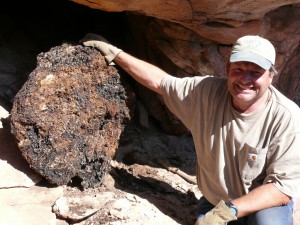
Mike Metcalf
Throughout his career, Mike has been a leader in archaeological research in the region, taking what is sometimes the everyday ordinary work of the typical cultural resource consultant and gleaning from it the anthropology that we all strive for. Mike seldom lost sight of this larger goal, and has continued, and continues, to contribute significantly to the knowledge base of Colorado archaeology. In addition to being a contributing or primary author of many of the company’s larger and more synthetic project reports, including leading several major interstate gas pipeline projects that have produced a wealth of information, Mike, along with Alan Reed, wrote the Northern Colorado River Basin prehistoric context for CCPA; contributed to Changing Perspectives of the Archaic on the Northwest Plains and Rocky Mountains, edited by Mary Lou Larson and Julie Frances; reported on the Alkali Creek Knife River Flint quarries excavations in North Dakota; excavated and reported, along with Kevin Black, the Yarmony Pit House Site in Eagle County; edited, along with David Madsen, Intermountain Archaeology, University of Utah Anthropological Papers no. 122.
Mike is a long-time member of the Society for American Archaeology, the Plains Anthropological Conference, Wyoming Association of Professional Archaeologists (past board member and past vice president), the Utah Professional Archaeological Council, the American Cultural Resource Association, and our own Colorado Council of Professional Archaeologists, where he has served as a board member, newsletter editor, and President. He is a co-founder of the Rocky Mountain Anthropological Conference, and is a current board member for Colorado Preservation, Inc.
Mike is now in a stage of his career that might be called peri-retirement, where he shows some of the primary symptoms of retirement, but is not yet fully retired. Metcalf Archaeological Consultants has been sold to the employees of the company and Mike remains President of the company and a principal investigator, focusing on continued research, passing on his skills and talents to the company’s staff, and fostering a continued tradition of significant and meaningful contributions to understanding the archaeology of Colorado.
Mike was inducted as a CCPA Fellow in 2013.
Elizabeth Ann Morris (1932-2012)
Elizabeth Morris was born to archaeologists Earl H. and Anne Axtell Morris in 1932. She graduated from Boulder High school in 1949, received her AB from Antioch College in 1954 and both her MA (1957) and PhD (1959) from the University of Arizona . While at Antioch College , Liz had an internship with Paul S. Martin and Elaine Bluhm at the Field Museum of Natural History in Chicago . This internship helped her decide to become an archaeologist.After receiving her degrees, Liz worked on the Iranian Prehistoric Project with Robert Braidwood and the Harvard Upper Paleolithic Project in France under the direction of Hallman Movius. She was a research assistant at the Laboratory of Tree Ring Research in Arizona and edited the southwestern archaeological journal Kiva.Elizabeth started her teaching career at Temple University but by 1970 had returned to Colorado to teach at Colorado State University (CSU). While there Liz served as the department chair as well as the Director of CSU’s field school. Since 1988 she has been a Professor Emerita at Colorado State University .
Liz has travelled all over the world doing archaeological, ethnographic and historical work. She has excavated or presented professional papers in Canada, Mexico, Russia, Austria, China, Israel, Iran, France and Denmark.
Officially retired Liz continues to pursue research at high-altitude sites in the Rockies and Basketmaker sites in the southwest.
Liz was inducted as a CCPA Fellow in 1992.
Alan Dean Reed (b. 1954)
Alan Reed grew up in Boulder and has been active in Colorado archaeology since the mid-1970s. He began his career as a student at the University of Colorado under Dr. David Breternitz before supervising the excavation of Dominguez Ruin for his Master’s thesis. 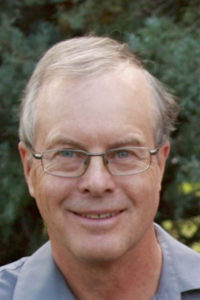 After receiving his Master’s degree, Alan entered the exciting era of early CRM with a strong academic background and a desire to make substantive contributions to Colorado archaeology that never waned over a career that spanned over 35 years. After a couple of short-term government and CRM stints, he spent nearly 10 years as a Project Director and Co-Principal Investigator at Nickens and Associates in Montrose. He married fellow former CU student and coworker Susan Chandler in 1979. In 1988, he founded Alpine Archaeological Consultants with Susan Chandler and Jon Horn.
After receiving his Master’s degree, Alan entered the exciting era of early CRM with a strong academic background and a desire to make substantive contributions to Colorado archaeology that never waned over a career that spanned over 35 years. After a couple of short-term government and CRM stints, he spent nearly 10 years as a Project Director and Co-Principal Investigator at Nickens and Associates in Montrose. He married fellow former CU student and coworker Susan Chandler in 1979. In 1988, he founded Alpine Archaeological Consultants with Susan Chandler and Jon Horn.
Many of the projects Alan directed or co-directed as a Principal Investigator remain some of the most important data recovery projects conducted over the past quarter-century in western Colorado. He is well known as a master synthesizer of large datasets and is highly respected for his research into Ute archaeology and the Formative period of west-central Colorado, where he defined the Gateway tradition. Alan was one of the pioneers of the use of alternative mitigation in Colorado and adjoining states, and the approaches he devised resulted in the generation of vast quantities of data and original research so rich that archaeologists will continue to mine them for many years to come. Through Alpine, he provided outstanding opportunities for fieldwork and research to a younger generation of archaeologists. Along with Susan Chandler and Jon Horn, his insistence on the highest standards of data collection and dissemination created a company-wide legacy that continues to thrive and serve Colorado archaeology. Alan has been a CCPA member since 1980 and served as a board member from 1983 to 1985 and newsletter editor in 1985 and 1986. He was CCPA President in 1988.
Alan retired at the end of 2011 to pursue his many non-archaeological interests, such as traveling, birding, bike riding, fishing, reading, and spending time with his family, including his four grandchildren.
Alan was inducted as a CCPA Fellow in 2017.
Omer Call Stewart (1908-1991)
Omer Stewart was born in Provo, Utah in 1908. He attended the University of Utah, earning a B.A. in anthropology in 1933. He went on to graduate school at the University of California-Berkeley, earning his Ph.D in 1939. His primary training and interest lay in ethnology, and spent much of his career working with the Ute, including a special emphasis on their peyote religion. His early archaeological experiences were as a cook for various expeditions into the Southwest, including Julian Steward at Promontory Point and Black Rock Cave in 1930, as well as Lynn Hargrave’s Rainbow Bridge and Monument Valley Expedition in 1933. He initially taught at the University of Texas, and then did a post-doctoral appointment at the University of Minnesota. He served in the Army during W.W. II from 1941 to 1945. Returning home after the war, he began his teaching career at the University of Colorado, and remained there until his retirement in 1974. He was responsible for developing a site form in 1947 for archaeological site recordation in Colorado. Following the death of CAS leader, C. T. Hurst, in 1949, Omer assumed the leadership as the Executive Secretary of the Colorado Archaeological Society, serving in that capacity until 1952. Omer always considered himself an avocational archaeologist, and remained a strong supporter of CAS throughout his lifetime, passing away in Boulder in 1991.
Omer was inducted as a CCPA Fellow in 1982.
Joe Ben Wheat (1916-1997)
Joe Ben Wheat (known affectionately to all as “Joe Ben”) was born in Van Horn, Texas in 1916.. His initial academic exposure to anthropology was at UC-Berkeley under the tutelage of giants Alfred Kroeber and Robert Lowie. He later received his M.A. and Ph.D. at the University of Arizona. Most in Colorado know him from his association with the University of Colorado Museum after he replaced Herb Dick as Curator of Anthropology. His expertise spanned the scope of New World prehistory. His report on his excavations at the Olson-Chubbuck site became a classic in Paleoindian studies. In addition to working at another Paleoindian kill, the Jurgens site, along the Kersey Terrace in NE Colorado, he spent many years with CU students excavating large complex Anasazi ruins north of Cortez around Yellow Jacket. He also became a world-renowned expert in Southwestern Native American textiles. Despite his busy schedule, Joe Ben was known for generously sharing his time with anyone who appeared at his door in the museum with a question or an artifact in need of identification. He began retirement in 1982, but continued his Yellow Jacket work for many years thereafter. He passed away in Boulder in 1997.
Joe Ben was inducted as a CCPA Fellow in 1982.
Hannah Marie Wormington Volk (1914-1994)
Marie Wormington was born in Denver in 1914 and remained a resident there the rest of her life. She was an East High School classmate of John Cotter, who also went on to fame in the archaeological profession. She received he B.A. at Denver University under E. B. Renaud, and then set out to gain field experience in Upper Paleolithic archaeology in France. Upon her return she was hired by J. D. Figgins (of Folsom site fame) as a staff archaeologist at the Denver Museum of Natural History, and served in that capacity for the next 31 years (with time out for graduate studies). She undertook graduate school at Radcliffe and Harvard, becoming only the second woman admitted into the Harvard anthropology department. Her mentors there were Clyde Kluckhohn and Kirk Bryan. She received her M.A. and Ph.D. from Radcliffe in 1950 and 1954. She undertook numerous archaeological excavations over the years, but is best known for her syntheses – especially Prehistoric Indians of the Southwest (1947) and the many editions of Ancient Man in North America (1939). She became the first woman president of the Society for American Archeology in 1958 and was honored by them with the SAA Distinguished Service Award in 1983. She remained active in the field up until her demise in her Denver home due to smoke inhalation in 1994 as the result of a smoldering cigarette.
Marie was inducted as a CCPA Fellow in 1982.
Christian John Zier (b. 1950)
Chris Zier hails from Boulder where he obtained M.A. and Ph.D. degrees from the University of Colorado (1976, 1981). He did his master’s thesis research at Zuni, New Mexico and dissertation research in the Zapotitán Valley of El Salvador. He has had the privilege of working for, and with, many outstanding archaeologists who strongly influenced his career, among them Joe Ben Wheat, David A. Breternitz, Jonathan Haas, Payson D. Sheets, Michael D. Metcalf, and Stephen M. Kalasz. 
His life in archaeology began at the University of Colorado-Mesa Verde field school in 1971. Over the course of the following decade he worked for the Museum of Northern Arizona (as Fellow in Anthropology), University of Colorado Museum, National Park Service-Interagency Archeological Services, Western Wyoming College, and Powers Elevation Co. In El Salvador in 1978 he was the first excavation supervisor at the Cerén site, now a UNESCO World Heritage Site. In 1980, with Michael D. Metcalf, he co-founded Metcalf-Zier Archaeologists, Inc., which operated under that name for four years. In 1984 he established Centennial Archaeology, Inc. which he owned and directed for 30 years, until 2014. He has worked throughout the western and central U.S. including the Great Plains, Rocky Mountains, Great Basin, Southwest, and Texas. He has a special affinity for the canyon-plains country of southeastern Colorado, having directed excavations at sites including Avery Ranch, Recon John Shelter, and Gooseberry Shelter, and interpreted the excavation history and archaeology of Trinchera Cave. He was lead author (with S. Kalasz, M. Mitchell, M. Painter, M. McFaul, and A. Holmes) of Colorado Prehistory: A Context for the Arkansas River Basin (1999). In addition to the U.S. and El Salvador, his work experience includes a paleontological expedition in Tunisia, archaeological investigations associated with mining projects in Mongolia, Pakistan, Peru, and Congo Republic, and development of cultural resource country profiles for the U.S. military in Afghanistan and Pakistan.
Chris has been a CCPA member since the mid-1980s and has served as President, board member, and ethics coordinator. Through Centennial Archaeology, Inc. he co-hosted (with Colorado State University) two CCPA annual meetings in Fort Collins. Other professional society memberships include Colorado Archaeological Society, Society for American Archaeology, Plains Anthropological Society, and International Association for Impact Assessment. He has secured grants to conduct archaeological studies at the Magic Mountain site, Boggsville, Trinchera Cave, and elsewhere. He is a long-time member of Sigma Xi, honorary scientific society.
Chris is proud of his family – his wife Denise and grown children Caroline, Abigail, and Daniel – without whom none of this would matter very much. Although officially retired from archaeology he is keeping a hand in it as editor of Southwestern Lore. He stays active with fly fishing, whitewater boating, endurance sports, entertaining grandchildren, and traveling to the most out-of-the-way places he can find.
Chris was inducted as a CCPA Fellow in 2018.





